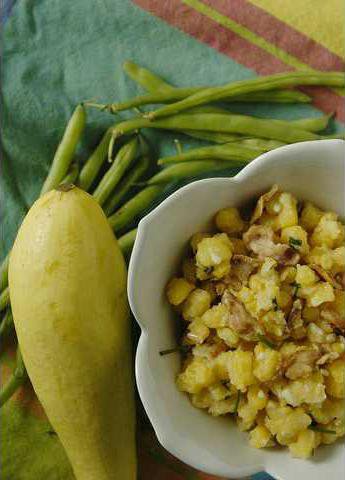0415cherokeeAUD
Bill Thomas, Cherokee cooking class teacher and author, talks about different ways to use hominy and other traditional Cherokee foods.Generations ago, Cherokee fished the area's rivers and hunted the animals roaming the mountains.
Today, their mark lives on mainly in names — the Chattahoochee River, for example, gives life to the man-made Lake Lanier that's an integral part of our culture.
But what about the food that came from the river, or the fertile land around it? Today, we can still find ingredients cultivated and cooked by the Cherokee, even though they now come in cans at the grocery store.
For example, hominy.
"You wouldn't have any corn (in the spring) but you would have hominy that was stored," said Bill Thomas, who teaches classes on Cherokee cooking and has written books on the culture. "Usually with hominy they do something with it, like they would make bean dumplings and would take the hominy and they can mix the hominy with spare ribs."
Fried Hominy, according to the Cherokee Web site, is a popular dish that was cooked among natives in the area. Hominy, a corn product, is mixed with wild green onions and bacon as a side dish.
During the spring, the Cherokee enjoyed fresh greens, like branch lettuce or ramps, and prepared a variety of hominy dishes.
"This time of the year Cherokees are basically focused on wild greens, and their principle wild green that they like is sochani," Thomas said. "It grows along creek banks and sandy areas mostly for the partial sun. They gather that plant, they gather the leaves and they boil it and then they usually season it with some pork, and that is their favorite green that they eat this time of year.
Thanks to readily available cans of hominy in your local grocery store, it's easy to replicate the traditional Fried Hominy dish - and there's only three ingredients.
First, fry the bacon while cutting green onions into small pieces. Remove the bacon and crumble it, then add onions to the pan. When the onions start frying add hominy and cook for about 10 to 15 minutes first on high heat, then on low. Mix in the bacon when you're done.
Thomas said some of the Cherokee corn dishes were used in religious ceremonies.
"There is a spiritual relationship to their food," he said. "A lot of their foods were used in religious ceremonies with different types of the corn."
The Cherokee have a long history in the Northeast Georgia area, which is what inspired Thomas to begin researching the tribe. Thomas' research blossomed into editing and writing books on the Cherokee and teaching seminars on Cherokee cooking.
A seminar was even scheduled as part of the Smithsonian exhibit, "Food For Thought," at North Georgia College & State University in Dahlonega. Thomas, a pathologist at the Northeast Georgia Medical Center, has also taught cooking classes at the John C. Campbell Folk School in North Carolina.
The most recent course at NGCSU was cancelled, but it spurred our interest to learn a little more about traditional Cherokee cooking.
"I did a lot of work, started working with the people of the Southern Appalachians, Southern Highlanders," Thomas said. "You need to learn from the indigenous people ... to learn more about their culture and their food in general."
Through his research he met authors Tony and Nancy Plemmons in Brasstown Bald. He edited one of their first Cherokee cookbooks, "Cherokee Cooking from the Mountains and Gardens to the Table."
"Nancy is a full-blooded Cherokee and she and her family were out of North Carolina. ... They published the first Cherokee cookbook that was written about Cherokee cooking," Thomas said.
Thomas also has written "Northeast Georgia Cuisine: A Gourmet Food Guide to the Southern Appalachian Mountains" and "The Foods of the Georgia Barrier Islands," a book on the coastal region of Georgia.
He added that Cherokee cooking is great food because of the interesting flavors and seasonings.
"Even with the variety of the world's food that you have, most of the flavors most of people are familiar with," Thomas said. "I think as more people start to experiment, you don't have to go around the world to find unusual flavors, you can find unusual flavors in ... insight from what you can find locally.
Other items that are popular in traditional Cherokee cooking include speckled trout, deer and groundhog, beans, squash, sunflower seeds, nuts, berries, plums and mushrooms.
"I try to take the traditional recipes and give them a modern spin," Thomas said.

